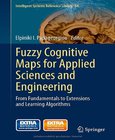Elpiniki I. Papageorgiou eBooks
Download free Elpiniki I. Papageorgiou eBooks
Fuzzy Cognitive Maps for Applied Sciences and Engineering
From Fundamentals to Extensions and Learning Algorithms
Fuzzy Cognitive Maps (FCM) constitute cognitive models in the form of fuzzy directed graphs consisting of two basic elements: the nodes, which basically correspond to concepts bearing different states of activation depending on the knowledge they represent, and the edges denoting the causal effects that each source node exercises on the receiving concept expressed through weights. Weights take values in the interval [-1,1], which denotes the positive, negative or neutral causal relationship between two concepts. An FCM can be typically obtained through linguistic terms, inherent to fuzzy systems, but with a structure similar to the neural networks, which facilitates data processing, and has capabilities for training and adaptation.During the last 10 ...
2007 - 2017 © eBooks-IT.org

